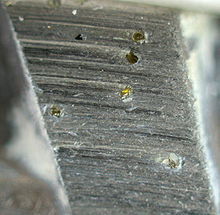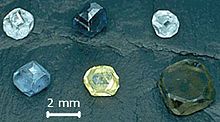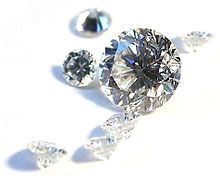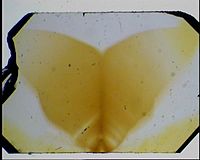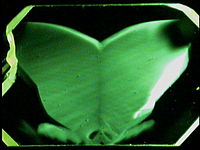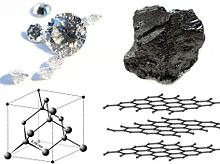- Material properties of diamond
-
This article addresses the material properties of diamond. For a broader discussion of diamonds, see diamond. For other uses of the word diamond, see diamond (disambiguation).
Diamond 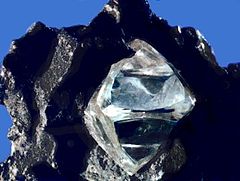
An octahedral diamond crystal in matrixGeneral Category Native Nonmetal, Mineral Chemical formula Carbon (C) Identification Color Most often colorless to yellow or brown. Rarely pink, orange, green, blue or gray. Crystal habit Octahedral, cubo-octahedral, spherical or cubic Crystal system Diamond cubic
(a = 3.56683 Å)Cleavage Octahedral; perfect and easy Fracture Conchoidal Mohs scale hardness 10 Streak white Diaphaneity Clear to not Specific gravity 3.516–3.525 Refractive index 2.417 Pleochroism None Fusibility Burns above 700 °C in air. Solubility Resistant to acids, but dissolves irreversibly in hot steel Major varieties Ballas Spherical, radial structure, cryptocrystalline, opaque black Bort Poorly formed, cryptocrystalline, shapeless, translucent Carbonado Massive, microcrystalline, opaque black Diamond is the allotrope of carbon in which the carbon atoms are arranged in the specific type of cubic lattice called diamond cubic. Diamond is an optically isotropic crystal that is transparent to opaque. Owing to its strong covalent bonding, diamond is the hardest naturally occurring material known. Yet, due to important structural weaknesses, diamond's toughness is only fair to good. The precise tensile strength of diamond is unknown, however strength up to 60 GPa has been observed, and it could be as high as 90–225 GPa depending on the crystal orientation. The anisotropy of diamond hardness is carefully considered during diamond cutting. Diamond has a high refractive index (2.417) and moderate dispersion (0.044) properties which give cut diamonds their brilliance. Scientists classify diamonds into four main types according to the nature of crystallographic defects present. Trace impurities substitutionally replacing carbon atoms in a diamond's crystal lattice, and in some cases structural defects, are responsible for the wide range of colors seen in diamond. Most diamonds are electrical insulators but extremely efficient thermal conductors. Unlike many other minerals, the specific gravity of diamond crystals (3.52) has rather small variation from diamond to diamond.
Contents
Hardness and crystal structure
Known to the ancient Greeks as ἀδάμας – adámas ("proper", "unalterable", "unbreakable")[1] and sometimes called adamant, diamond is the hardest known naturally occurring material, scoring 10 on the Mohs scale of mineral hardness. Diamond is extremely strong due to the structure of its carbon atoms, where each carbon atom has four neighbors joined to it with covalent bonds. The material boron nitride, when in a form structurally identical to diamond (zincblende structure), is nearly as hard as diamond; a currently hypothetical material, beta carbon nitride, may also be as hard or harder in one form. It has been shown that some diamond aggregates having nanometer grain size are harder and tougher than conventional large diamond crystals, thus they perform better as abrasive material.[2][3] Due to the use of those new ultra-hard materials for diamond testing, more accurate values are now known for diamond hardness. A surface perpendicular to the [111] crystallographic direction (that is the longest diagonal of a cube) of a pure (i.e. type IIa) diamond has a hardness value of 167 GPa when scratched with an nanodiamond tip, while the nanodiamond sample itself has a value of 310 GPa when tested with another nanodiamond tip. Because the test only works properly with a tip made of harder material than the sample being tested, the true value for nanodiamond is likely somewhat lower than 310 GPa.[2]
The precise tensile strength of diamond is unknown, however strength up to 60 GPa has been observed, and it could be as high as 90–225 GPa depending on the perfection of diamond lattice and on its orientation: Tensile strength is the highest for the [100] crystal direction (normal to the cubic face), smaller for the [110] and the smallest for the [111] axis (along the longest cube diagonal).[4]
Cubic diamonds have a perfect and easy octahedral cleavage, which means that they only have four planes—weak directions following the faces of the octahedron where there are fewer bonds—along which diamond can easily split upon blunt impact to leave a smooth surface. Similarly, diamond's hardness is markedly directional: the hardest direction is the diagonal on the cube face, 100 times harder than the softest direction, which is the dodecahedral plane. The octahedral plane is intermediate between the two extremes. The diamond cutting process relies heavily on this directional hardness, as without it a diamond would be nearly impossible to fashion. Cleavage also plays a helpful role, especially in large stones where the cutter wishes to remove flawed material or to produce more than one stone from the same piece of rough (see, e.g., Cullinan Diamond).[5]
Animation of the diamond's crystal structure.
Diamonds crystallize in the diamond cubic crystal system (space group Fd3m) and consist of tetrahedrally, covalently bonded carbon atoms. A second form called lonsdaleite, with hexagonal symmetry, has also been found, but it is extremely rare and forms only in meteorites or in laboratory synthesis. The local environment of each atom is identical in the two structures. From theoretical considerations, lonsdaleite is expected to be harder than diamond, but the size and quality of the available stones are insufficient to test this hypothesis.[6] In terms of crystal habit, diamonds occur most often as euhedral (well-formed) or rounded octahedra and twinned, flattened octahedra with a triangular outline. Other forms include dodecahedra and (rarely) cubes. There is evidence that nitrogen impurities play an important role in the formation of well-shaped euhedral crystals. The largest diamonds found, such as the Cullinan Diamond, were shapeless. These diamonds are pure (i.e. type II) and therefore contain little if any nitrogen.[5]
The faces of diamond octahedrons are highly lustrous due to their hardness; triangular shaped growth defects (trigons) or etch pits are often present on the faces. A diamond's fracture may be step-like, conchoidal (shell-like, similar to glass) or irregular. Diamonds which are nearly round, due to the formation of multiple steps on octahedral faces, are commonly coated in a gum-like skin (nyf). The combination of stepped faces, growth defects, and nyf produces a "scaly" or corrugated appearance. Many diamonds are so distorted that few crystal faces are discernible. Some diamonds found in Brazil and the Democratic Republic of the Congo are polycrystalline and occur as opaque, darkly colored, spherical, radial masses of tiny crystals; these are known as ballas and are important to industry as they lack the cleavage planes of single-crystal diamond. Carbonado is a similar opaque microcrystalline form which occurs in shapeless masses. Like ballas diamond, carbonado lacks cleavage planes and its specific gravity varies widely from 2.9 to 3.5. Bort diamonds, found in Brazil, Venezuela, and Guyana, are the most common type of industrial-grade diamond. They are also polycrystalline and often poorly crystallized; they are translucent and cleave easily.[5]
Due to its great hardness and strong molecular bonding, a cut diamond's facets and facet edges appear the flattest and sharpest. A curious side effect of diamond's surface perfection is hydrophobia combined with lipophilia. The former property means a drop of water placed on a diamond will form a coherent droplet, whereas in most other minerals the water would spread out to cover the surface. Similarly, diamond is unusually lipophilic, meaning grease and oil readily collect on a diamond's surface. Whereas on other minerals oil would form coherent drops, on a diamond the oil would spread. This property is exploited in the use of so-called "grease pens," which apply a line of grease to the surface of a suspect diamond simulant. Diamond surfaces are hydrophobic when the surface carbon atoms terminate with a hydrogen atom and hydrophilic when the surface atoms terminate with an oxygen atom or hydroxyl radical. Treatment with gases or plasmas containing the appropriate gas, at temperatures of 450 °C or higher, can change the surface property completely.[7] Naturally occurring diamonds have a surface with less than a half monolayer coverage of oxygen, the balance being hydrogen and the behavior is moderately hydrophobic. This allows for separation from other minerals at the mine using the so-called "grease-belt".[8]
Toughness
Unlike hardness, which only denotes resistance to scratching, diamond's toughness or tenacity is only fair to good. Toughness relates to the ability to resist breakage from falls or impacts. Due to diamond's perfect and easy cleavage, it is vulnerable to breakage. A diamond will shatter if hit with an ordinary hammer. The toughness of natural diamond has been measured as 2.0 MPa m1/2, which is good compared to other gemstones, but poor compared to most engineering materials. As with any material, the macroscopic geometry of a diamond contributes to its resistance to breakage. Diamond has a cleavage plane and is therefore more fragile in some orientations than others. Diamond cutters use this attribute to cleave some stones, prior to faceting.[9][10]
Ballas and carbonado diamond are exceptional, as they are polycrystalline and therefore much tougher than single-crystal diamond; they are used for deep-drilling bits and other demanding industrial applications.[11] Particular faceting shapes of diamonds are more prone to breakage and thus may be uninsurable by reputable insurance companies. The brilliant cut of gemstones is designed specifically to reduce the likelihood of breakage or splintering.[5]
Solid foreign crystals are commonly present in diamond. They are mostly minerals, such as olivine, garnets, ruby, and many others.[12] These and other inclusions, such as internal fractures or "feathers", can compromise the structural integrity of a diamond. Cut diamonds that have been enhanced to improve their clarity via glass infilling of fractures or cavities are especially fragile, as the glass will not stand up to ultrasonic cleaning or the rigors of the jeweler's torch. Fracture-filled diamonds may shatter if treated improperly.[13]
Optical properties
Color and its causes
Diamonds occur in various colors — black, brown, yellow, gray, white, blue, orange, purple to pink and red. Colored diamonds contain crystallographic defects, including substitutional impurities and structural defects, that cause the coloration. Theoretically, pure diamonds would be transparent and colorless. Diamonds are scientifically classed into two main types and several subtypes, according to the nature of defects present and how they affect light absorption:[5]
Type I diamond has nitrogen (N) atoms as the main impurity, at a concentration of up to 1%. If the N atoms are in pairs or larger aggregates, they do not affect the diamond's color; these are Type Ia. About 98% of gem diamonds are type Ia: these diamonds belong to the Cape series, named after the diamond-rich region formerly known as Cape Province in South Africa, whose deposits are largely Type Ia. If the nitrogen atoms are dispersed throughout the crystal in isolated sites (not paired or grouped), they give the stone an intense yellow or occasionally brown tint (type Ib); the rare canary diamonds belong to this type, which represents only ~0.1% of known natural diamonds. Synthetic diamond containing nitrogen is usually of type Ib. Type Ia and Ib diamonds absorb in both the infrared and ultraviolet region of the electromagnetic spectrum, from 320 nm. They also have a characteristic fluorescence and visible absorption spectrum (see Optical properties).[14]
Type II diamonds have very few if any nitrogen impurities. Pure (type IIa) diamond can be colored pink, red, or brown due to structural anomalies arising through plastic deformation during crystal growth[15] — these diamonds are rare (1.8% of gem diamonds), but constitute a large percentage of Australian diamonds. Type IIb diamonds, which account for ~0.1% of gem diamonds, are usually a steely blue or gray due to boron atoms scattered within the crystal matrix. These diamonds are also semiconductors, unlike other diamond types (see Electrical properties). Most blue-gray diamonds coming from the Argyle mine of Australia are not of type IIb, but of Ia type. Those diamonds contain large concentrations of defects and impurities (especially hydrogen and nitrogen) and the origin of their color is yet uncertain.[16] Type II diamonds weakly absorb in a different region of the infrared (the absorption is due to the diamond lattice rather than impurities), and transmit in the ultraviolet below 225 nm, unlike type I diamonds. They also have differing fluorescence characteristics, but no discernible visible absorption spectrum.[14]
Certain diamond enhancement techniques are commonly used to artificially produce an array of colors, including blue, green, yellow, red, and black. Color enhancement techniques usually involve irradiation, including proton bombardment via cyclotrons; neutron bombardment in the piles of nuclear reactors; and electron bombardment by Van de Graaff generators. These high-energy particles physically alter the diamond's crystal lattice, knocking carbon atoms out of place and producing color centers. The depth of color penetration depends on the technique and its duration, and in some cases the diamond may be left radioactive to some degree.[5][17]
Some irradiated diamonds are completely natural — one famous example is the Dresden Green Diamond.[18] In these natural stones the color is imparted by "radiation burns" (natural irradiation by alpha particles originating from uranium ore) in the form of small patches, usually only microns deep. Additionally, Type IIa diamonds can have their structural deformations "repaired" via a high-pressure high-temperature (HPHT) process, removing much or all of the diamond's color.[19]
Luster
The luster of a diamond is described as 'adamantine', which simply means diamond-like. Reflections on a properly cut diamond's facets are undistorted, due to their flatness. The refractive index of diamond (as measured via sodium light, 589.3 nm) is 2.417. Because it is cubic in structure, diamond is also isotropic. Its high dispersion of 0.044 (variation of refractive index across the visible spectrum) manifests in the perceptible fire of cut diamonds. This fire—flashes of prismatic colors seen in transparent stones—is perhaps diamond's most important optical property from a jewelry perspective. The prominence or amount of fire seen in a stone is heavily influenced by the choice of diamond cut and its associated proportions (particularly crown height), although the body color of fancy (i.e., unusual) diamonds may hide their fire to some degree.[17]
Many other minerals have higher dispersion (that is difference in refractive index for blue and red light) than diamond: sphene 0.051, andradite 0.057, cassiterite 0.071, SrTiO3 0.109, sphalerite 0.156, synthetic rutile 0.330.[20] However, the combination of dispersion with extreme hardness, wear and chemical resistivity, as well as clever marketing, determines the exceptional value of diamond as a gemstone.
Fluorescence
Fluorescence tests for impurities
A micrograph (top) and UV-excited photoluminescence (bottom) from a plate cut from a synthetic diamond (width ~3 mm). Most of yellow color and green emission originate from nickel impurities.Diamonds exhibit fluorescence, that is, they emit light of various colors and intensities under long-wave ultra-violet light (365 nm): Cape series stones (type Ia) usually fluoresce blue, and these stones may also phosphoresce yellow, a unique property among gemstones. Other possible long-wave fluorescence colors are green (usually in brown stones), yellow, mauve, or red (in type IIb diamonds).[21] In natural diamonds, there is typically little if any response to short-wave ultraviolet, but the reverse is true of synthetic diamonds. Some natural type IIb diamonds phosphoresce blue after exposure to short-wave ultraviolet. In natural diamonds, fluorescence under X-rays is generally bluish-white, yellowish or greenish. Some diamonds, particularly Canadian diamonds, show no fluorescence.[14][17]
The origin of the luminescence colors is often unclear and not unique. Blue emission from type IIa and IIb diamonds is reliably identified with dislocations by directly correlating the emission with dislocations in an electron microscope.[22] However, blue emission in type Ia diamond could be either due to dislocations or the N3 defects (three nitrogen atoms bordering a vacancy).[23] Green emission in natural diamond is usually due to the H3 center (two substitutional nitrogen atoms separated by a vacancy),[24] whereas in synthetic diamond it usually originates from nickel used as a catalyst (see figure).[14] Orange or red emission could be due to various reasons, one being the nitrogen-vacancy center which is present in sufficient quantities in all types of diamond, even type IIb.[25]
Optical absorption
Cape series (Ia) diamonds have a visible absorption spectrum (as seen through a direct-vision spectroscope) consisting of a fine line in the violet at 415.5 nm; however, this line is often invisible until the diamond has been cooled to very low temperatures. Associated with this are weaker lines at 478 nm, 465 nm, 452 nm, 435 nm, and 423 nm. All those lines are labeled as N3 and N2 optical centers and associated with a defect consisting of three nitrogen atoms bordering a vacancy. Other stones show additional bands: brown, green, or yellow diamonds show a band in the green at 504 nm (H3 center, see above),[24] sometimes accompanied by two additional weak bands at 537 nm and 495 nm (H4 center, a large complex presumably involving 4 substitutional nitrogen atoms and 2 lattice vacancies).[26] Type IIb diamonds may absorb in the far red due to the substitutional boron, but otherwise show no observable visible absorption spectrum.[5]
Gemological laboratories make use of spectrophotometer machines that can distinguish natural, artificial, and color-enhanced diamonds. The spectrophotometers analyze the infrared, visible, and ultraviolet absorption and luminescence spectra of diamonds cooled with liquid nitrogen to detect tell-tale absorption lines that are not normally discernible.[5][27]
Electrical properties
Main article: Covalent superconductorsExcept for most natural blue diamonds, which are semiconductors due to substitutional boron impurities replacing carbon atoms, diamond is a good electrical insulator. Natural blue or blue-gray diamonds, common for the Argyle diamond mine in Australia, are rich in hydrogen; these diamonds are not semiconductors and it is unclear whether hydrogen is actually responsible for their blue-gray color.[16] Natural blue diamonds containing boron and synthetic diamonds doped with boron are p-type semiconductors. N-type diamond films are reproducibly synthesized by phosphorus doping during chemical vapor deposition.[28] Diode p-n junctions and UV light emitting diodes (LEDs, at 235 nm) have been produced by sequential deposition of p-type (boron-doped) and n-type (phosphorus-doped) layers.[29] Diamond transistors have been produced.
In April 2004, the journal Nature reported that below the superconducting transition temperature 4 K, boron-doped diamond synthesized at high temperature and high pressure is a bulk superconductor.[30] Superconductivity was later observed in heavily boron-doped films grown by various chemical vapor deposition techniques, and the highest reported transition temperature (by 2009) is 11.4 K.[31][32]
Thermal conductivity
Unlike most electrical insulators, diamond is a good conductor of heat because of the strong covalent bonding within the crystal. Most natural blue diamonds contain boron atoms which replace carbon atoms in the crystal matrix, and also have high thermal conductance. Thermal conductivity of natural diamond was measured to be about 22 W/(cm·K). Monocrystalline synthetic diamond enriched in 12C isotope (99.9%) has the highest thermal conductivity of any known solid at room temperature: 33.2 W/(cm·K),[33][34] five times more than copper. Because diamond has such high thermal conductance it is already used in semiconductor manufacture to prevent silicon and other semiconducting materials from overheating. At lower temperatures conductivity becomes even better as its Fermi electrons can match the phononic normal transport mode near the Debye point,[35] and thermal conductivity reaches 410 W/(cm·K) at 104 K (12C-enriched diamond).[34]
Diamond's high thermal conductivity is used by jewelers and gemologists who may employ an electronic thermal probe to separate diamonds from their imitations. These probes consist of a pair of battery-powered thermistors mounted in a fine copper tip. One thermistor functions as a heating device while the other measures the temperature of the copper tip: if the stone being tested is a diamond, it will conduct the tip's thermal energy rapidly enough to produce a measurable temperature drop. This test takes about 2–3 seconds. However, older probes will be fooled by moissanite, a crystalline mineral form of silicon carbide introduced in 1998 as an alternative to diamonds, which has a similar thermal conductivity.[5][27]
Thermal stability
Being a form of carbon, diamond oxidizes in air if heated over 700 °C.[36] In absence of oxygen, e.g. in a flow of high-purity argon gas, diamond can be heated up to about 1700 °C.[37][38] Its surface blackens, but can be recovered by re-polishing. At high pressure (~20 GPa) diamond can be heated up to 2500 °C,[39] and a report published in 2009 suggests that diamond can withstand temperatures of 3000 °C and above.[40]
Diamonds are carbon crystals that form deep within the Earth under high temperatures and extreme pressures. At surface air pressure (one atmosphere), diamonds are not as stable as graphite, and so the decay of diamond is thermodynamically favorable (δH = −2 kJ / mol).[17] So, contrary to De Beers' ad campaign extending from 1948 to at least 2006 under the slogan "A diamond is forever",[41] diamonds are definitely not forever. However, owing to a very large kinetic energy barrier, diamonds are metastable; they will not decay into graphite under normal conditions.[17]
See also
References
- ^ Liddell, H.G.; Scott, R.. "Adamas". A Greek-English Lexicon. Perseus Project. http://www.perseus.tufts.edu/cgi-bin/ptext?doc=Perseus%3Atext%3A1999.04.0057%3Aentry%3D%231145.
- ^ a b Blank, V. et al. (1998). "Ultrahard and superhard phases of fullerite C60: comparison with diamond on hardness and wear". Diamond and Related Materials 7 (2–5): 427. doi:10.1016/S0925-9635(97)00232-X. http://www.nanoscan.info/files/article_03.pdf.
- ^ Irifune T, Kurio A, Sakamoto S, Inoue T, Sumiya H. (2003). "Ultrahard polycrystalline diamond from graphite". Nature 421 (6923): 599. doi:10.1038/421599b. PMID 12571587. http://www.nature.com/nature/journal/v421/n6923/full/421599b.html.
- ^ Telling, R. H.; C. J. Pickard, M. C. Payne, and J. E. Field (2000). "Theoretical Strength and Cleavage of Diamond". Physical Review Letters 84 (22): 5160–5163. Bibcode 2000PhRvL..84.5160T. doi:10.1103/PhysRevLett.84.5160. PMID 10990892.
- ^ a b c d e f g h i P. G. Read (1999). Gemmology (2nd ed., available on Google Books). Butterworth-Heinemann, Great Britain. pp. 52, 53, 275, 276. ISBN 0-7506-4411-7.
- ^ Pan, Zicheng; Sun, Hong; Zhang, Yi; and Chen, Changfeng (2009). "Harder than Diamond: Superior Indentation Strength of Wurtzite BN and Lonsdaleite". Physical Review Letters 102 (5): 055503. Bibcode 2009PhRvL.102e5503P. doi:10.1103/PhysRevLett.102.055503. PMID 19257519. Lay summary – Physorg.com (12-02-2009).
- ^ R.G., J; Copperthwaite, R; Derry, T; Pratt, J (1989). "A tensiometric study of Diamond(111) and(110) faces". Journal of colloid and interface science 130 (2): 347–358. doi:10.1016/0021-9797(89)90114-8.
- ^ Harlow, G. E. (1998). The nature of diamonds. Cambridge University Press. p. 223. ISBN 0521629357.
- ^ Weber, M. J. (2002). Handbook of optical materials. CRC Press. p. 119 (available on Google Books). ISBN 0849335124.
- ^ Field, J. E.; Freeman, C. J. (1981). "Strength and Fracture Properties of Diamond". Philosophical Magazine A (Taylor and Francis Ltd) 43 (3): 595–618. Bibcode 1981PMagA..43..595F. doi:10.1080/01418618108240397.
- ^ Moriyoshi, Y. et al. (1983). "The microstructure of natural polycrystal diamond, carbonado and ballas". Journal of Materials Science 18 (1): 217. Bibcode 1983JMatS..18..217M. doi:10.1007/BF00543828.
- ^ Iakoubovskii, K.; Adriaenssens, Guy J (2002). "Comment on `Evidence for a Fe-related defect centre in diamond'". Journal of Physics Condensed Matter 14 (21): 5459. Bibcode 2002JPCM...14.5459I. doi:10.1088/0953-8984/14/21/401.
- ^ Taylor, W.R., Lynton A.J. & Ridd, M. (1990). "Nitrogen defect aggregation of some Australasian diamonds: Time-temperature constraints on the source regions of pipe and alluvial diamonds" (PDF). American Mineralogist 75: 1290–1310. http://www.minsocam.org/ammin/AM75/AM75_1290.pdf.
- ^ a b c d Walker, J. (1979). "Optical absorption and luminescence in diamond". Rep. Prog. Phys. 42 (10): 1605–1659. Bibcode 1979RPPh...42.1605W. doi:10.1088/0034-4885/42/10/001.
- ^ Hounsome, L. S. et al. (2006). "Origin of brown coloration in diamond". Phys. Rev. B 73 (12): 125203. Bibcode 2006PhRvB..73l5203H. doi:10.1103/PhysRevB.73.125203.
- ^ a b Iakoubovskii, K (2002). "Optical characterization of natural Argyle diamonds". Diamond and Related Materials 11 (1): 125. doi:10.1016/S0925-9635(01)00533-7.
- ^ a b c d e Webster, R. and Read, P. G. (2000). Gems: Their sources, descriptions and identification. Butterworth-Heinemann, Great Britain. ISBN 0-7506-1674-1.
- ^ "The Dresden Green". http://famousdiamonds.tripod.com/dresdengreendiamond.html. Retrieved 2009-05-05.
- ^ Collins, A. T. et al. (2005). "High-temperature annealing of optical centers in type-I diamond". J. Appl. Phys. 97 (8): 083517. Bibcode 2005JAP....97h3517C. doi:10.1063/1.1866501.
- ^ "Optical study of defects in diamond", K. Iakoubovskii, PhD thesis, University of Leuven, 2000
- ^ Eaton-Magaña, Sally et al. (January 2008). "Using phosphorescence as a fingerprint for the Hope and other blue diamonds" (abstract). Geology (Geological Society of America) 36 (1): 83–6. doi:10.1130/G24170A.1. http://geology.geoscienceworld.org/cgi/content/abstract/36/1/83.
- ^ Hanley, P. L.; Kiflawi, I. and Lang, A. R. (1977). "On Topographically Identifiable Sources of Cathodoluminescence in Natural Diamonds". Phil. Trans. Roy. Soc. A 284 (1324): 329. Bibcode 1977RSPTA.284..329H. doi:10.1098/rsta.1977.0012.
- ^ van Wyk, J. A. (1982). "Carbon-12 hyperfine interaction of the unique carbon of the P2 (ESR) or N3 (optical) centre in diamond". Journal of Physics C Solid State Physics 15 (27): L981. Bibcode 1982JPhC...15L.981V. doi:10.1088/0022-3719/15/27/007.
- ^ a b Davies, G. et al. (1976). "The H3 (2.463 eV) Vibronic Band in Diamond: Uniaxial Stress Effects and the Breakdown of Mirror Symmetry". Proc. Roy. Soc. A 351 (1665): 245. Bibcode 1976RSPSA.351..245D. doi:10.1098/rspa.1976.0140.
- ^ Freitas, J. A. et al. (1993). "Observation of new vibronic luminescence band in semiconducting diamond". Electronics Letters 29 (19): 1727. doi:10.1049/el:19931148.
- ^ Sa, E. S. De (1977). "Uniaxial Stress Studies of the 2.498 eV (H4), 2.417 eV and 2.536 eV Vibronic Bands in Diamond". Proc. Roy. Soc. A 357 (1689): 231. doi:10.1098/rspa.1977.0165.
- ^ a b O'Donoghue, M. and Joyner, L. (2003). Identification of gemstones. Butterworth-Heinemann, Great Britain. ISBN 0-7506-5512-7.
- ^ Koizumi, S.; Nebel, C. E. and Nesladek, M (2008). Physics and Applications of CVD Diamond. Wiley VCH. pp. 200–240. ISBN 3527408010. http://books.google.com/?id=pRFUZdHb688C.
- ^ Koizumi, S. et al. (2001). "Ultraviolet Emission from a Diamond pn Junction". Science 292 (5523): 1899. Bibcode 2001Sci...292.1899K. doi:10.1126/science.1060258. PMID 11397942. http://www.sciencemag.org/cgi/content/abstract/292/5523/1899.
- ^ Ekimov, E. et al. (2004). "Superconductivity in diamond". Nature 428 (6982): 542. arXiv:cond-mat/0404156. Bibcode 2004Natur.428..542E. doi:10.1038/nature02449. PMID 15057827. http://www.nims.go.jp/NFM/paper1/SuperconductingDiamond/01nature02449.pdf.
- ^ Takano, Y. et al. (2007). "Superconducting properties of homoepitaxial CVD diamond". Diam. Relat. Mater. 16 (4–7): 911. doi:10.1016/j.diamond.2007.01.027.
- ^ Takano, Y. (2006). "Overview". Sci. Technol. Adv. Mater. 7 (S1): S1. Bibcode 2006STAdM...7S...1T. doi:10.1016/j.stam.2006.06.003. http://www.iop.org/EJ/article/1468-6996/7/S1/A01/STAM_7_S1_A01.pdf.
- ^ Anthony, T. R.; Banholzer, W. F.; Fleischer, J. F.; Wei, Lanhua; Kuo, P. K.; Thomas, R. L.; Pryor, R. W. (1989-12-27). "Thermal conductivity of isotopically enriched 12C diamond". Physical Review B 42 (2): 1104–1111. Bibcode 1990PhRvB..42.1104A. doi:10.1103/PhysRevB.42.1104. http://link.aps.org/doi/10.1103/PhysRevB.42.1104.
- ^ a b Wei, Lanhua; Kuo, P. K.; Thomas, R. L.; Anthony, T. R.; Banholzer, W. F. (1993-02-16). "Thermal conductivity of isotopically modified single crystal diamond". Physical Review Letters 70 (24): 3764–3767. Bibcode 1993PhRvL..70.3764W. doi:10.1103/PhysRevLett.70.3764. PMID 10053956. http://link.aps.org/doi/10.1103/PhysRevLett.70.3764.
- ^ "Carbon Nanotubes: Thermal Properties" (PDF). http://hone.mech.columbia.edu/pdf/hone_thermal_ency_nano.pdf. Retrieved 2009-06-06.
- ^ John, P (2002). "The oxidation of (100) textured diamond". Diamond and Related Materials 11 (3–6): 861. doi:10.1016/S0925-9635(01)00673-2.
- ^ Davies, G. and Evans, T. (1972). "Graphitization of Diamond at Zero Pressure and at a High Pressure". Proceedings of the Royal Society a Mathematical Physical and Engineering Sciences 328 (1574): 413. Bibcode 1972RSPSA.328..413D. doi:10.1098/rspa.1972.0086.
- ^ Evans, T.; James, P. F. (1964). "A Study of the Transformation of Diamond to Graphite". Proc. Roy. Soc. A 277 (1369): 260. Bibcode 1964RSPSA.277..260E. doi:10.1098/rspa.1964.0020.
- ^ Evans, T; Maguire, J; Maguire, J (1981). "The stages of nitrogen aggregation in diamond". Journal of Physics C Solid State Physics 14 (12): L379. Bibcode 1981JPhC...14L.379E. doi:10.1088/0022-3719/14/12/005.
- ^ Shatskiy, A. et al. (2009). "Boron-doped diamond heater and its application to large-volume, high-pressure, and high-temperature experiments". Rev. Sci. Instrum. 80 (2): 023907. Bibcode 2009RScI...80b3907S. doi:10.1063/1.3084209. PMID 19256662.
- ^ "A diamond is forever". http://www.phrases.org.uk/meanings/a-diamond-is-forever.html. Retrieved 2009-05-05.
Further reading
- Pagel-Theisen, Verena. (2001). Diamond grading ABC: The manual (9th ed.), pp. 84–85. Rubin & Son n.v.; Antwerp, Belgium. ISBN 3-9800434-6-0
- Webster, Robert, and Jobbins, E. Allan (Ed.). (1998). Gemmologist's compendium, p. 21, 25, 31. St Edmundsbury Press Ltd, Bury St Edwards. ISBN 0-7198-0291-1
- Properties of diamond (S. Sque, PhD thesis, 2005, University of Exeter, UK)
External links
Wikimedia Foundation. 2010.

